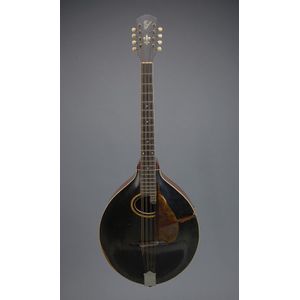Gibson Mandocello, 1912
American mandocello, by Gibson, serial number 2763, circa 1912, inlaid 'The Gibson' to headstock with fleur de lis in Mother-of-pearl. Paper label to interior, 98 cm long
You must be a subscriber, and be logged in to view price and dealer details.
Subscribe Now to view actual auction price for this item
When you subscribe, you have the option of setting the currency in which to display prices to $Au, $US, $NZ or Stg.
This item has been sold, and the description, image and price are for reference purposes only.
- Mother-Of-Pearl - Mother-of-pearl, technical name "nacre", is the inner layer of a sea shell. The iridescent colours and strength of this material were widely used in the nineteenth century as an inlay in jewellery, furniture, (especially papier mache furniture) and musical instruments.
In the early 1900s it was used to make pearl buttons. Mother-of-pearl is a soft material that is easily cut or engraved.
Nowadays it is a by-product of the oyster, freshwater pearl mussel and abalone industries. - Fleur-De-Lis - The fleur-de-lis is a stylized lily or iris flower with
three petals that has been used as a decorative motif for thousands of years. It
often appears in Christian iconography symbolising the Holy Trinity and as an
emblem that reflects the purity of the Virgin Mary. In decorative art and antiques
decoration, the fleur-de-lis is often used as a symbol of elegance, refinement,
and good taste.
The fleur-de-lis has a rich history and in ancient times, it
was associated with royalty, purity, and the divine, and it was used as a
symbol of the French monarchy for many centuries.
It is a common design element in ceramics, silverware, jewellery,
furniture, and other decorative objects, and it can be found in many different
styles and forms. - Circa - A Latin term meaning 'about', often used in the antique trade to give an approximate date for the piece, usually considered to be five years on either side of the circa year. Thus, circa 1900 means the piece was made about 1900, probably between 1895 and 1905. The expression is sometimes abbreviated to c.1900.
This item has been included into following indexes:
Visually similar items

French wall tapestry 'Chasse a Courre De Detti', width 265 cm x height 150 cm
Sold by
in
for
You can display prices in $Au, $US, $NZ or Stg.

Three tortoiseshell and pique hair pins
Sold by
in
for
You can display prices in $Au, $US, $NZ or Stg.

A pair of gilt bronze, brass and copper moderator lamps, possibly by Maison Hanniet Brussels, circa 1845, embossed JS to the base, 57 cm high
Sold by
in
for
You can display prices in $Au, $US, $NZ or Stg.

A large Ambrym Island drum, Vanuatu. Provenance: David Baker Collection.
Sold by
in
for
You can display prices in $Au, $US, $NZ or Stg.
